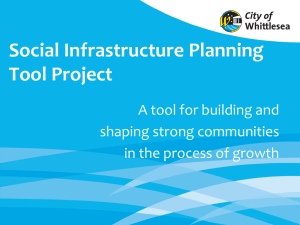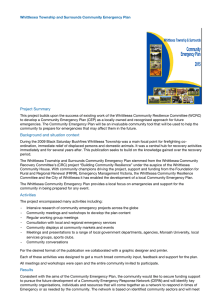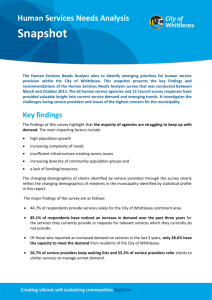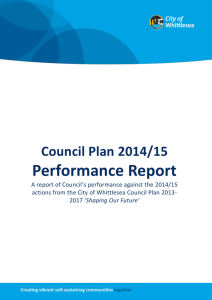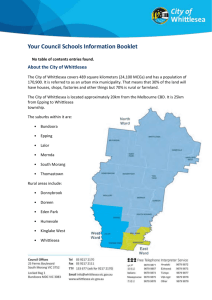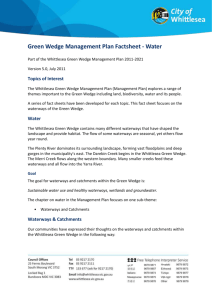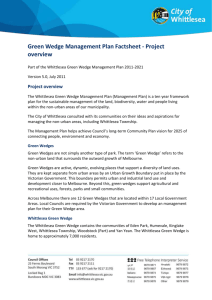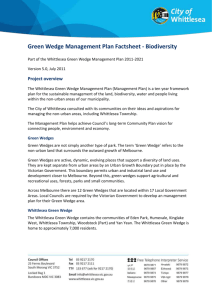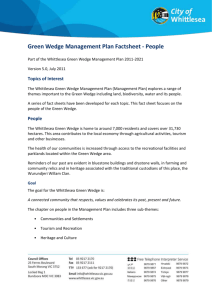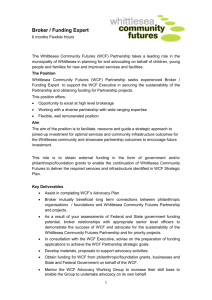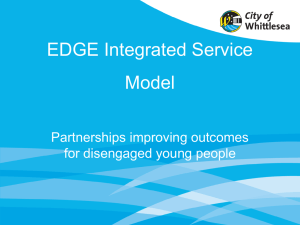Children and Families Prevention and early intervention in the early
advertisement
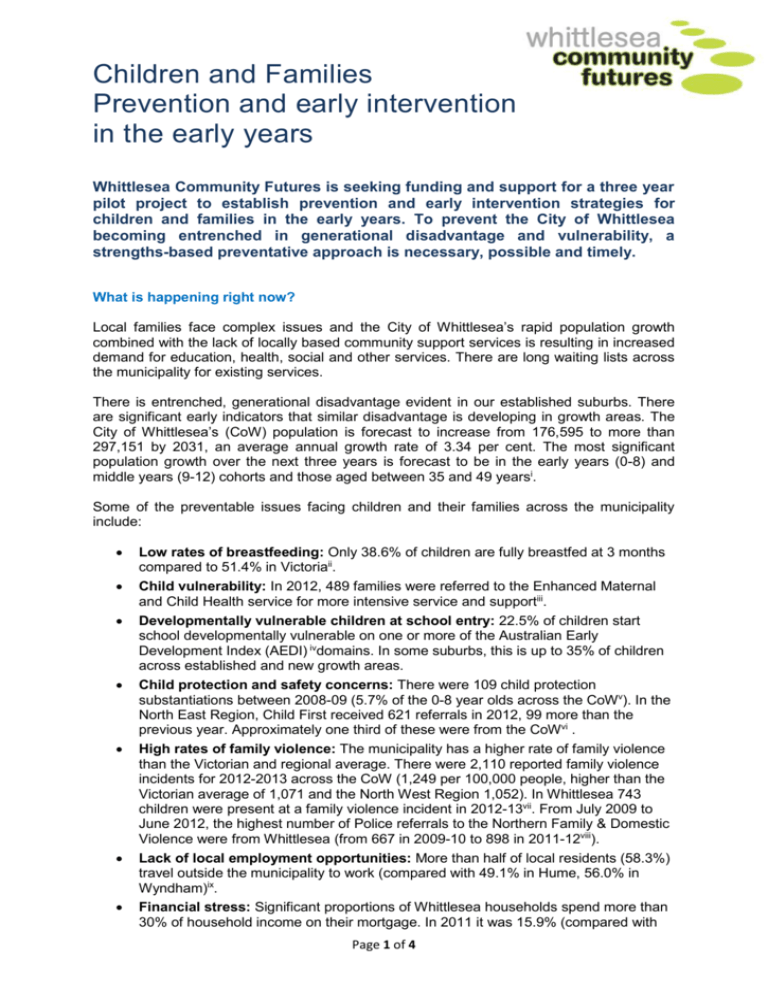
Children and Families Prevention and early intervention in the early years Whittlesea Community Futures is seeking funding and support for a three year pilot project to establish prevention and early intervention strategies for children and families in the early years. To prevent the City of Whittlesea becoming entrenched in generational disadvantage and vulnerability, a strengths-based preventative approach is necessary, possible and timely. What is happening right now? Local families face complex issues and the City of Whittlesea’s rapid population growth combined with the lack of locally based community support services is resulting in increased demand for education, health, social and other services. There are long waiting lists across the municipality for existing services. There is entrenched, generational disadvantage evident in our established suburbs. There are significant early indicators that similar disadvantage is developing in growth areas. The City of Whittlesea’s (CoW) population is forecast to increase from 176,595 to more than 297,151 by 2031, an average annual growth rate of 3.34 per cent. The most significant population growth over the next three years is forecast to be in the early years (0-8) and middle years (9-12) cohorts and those aged between 35 and 49 yearsi. Some of the preventable issues facing children and their families across the municipality include: Low rates of breastfeeding: Only 38.6% of children are fully breastfed at 3 months compared to 51.4% in Victoriaii. Child vulnerability: In 2012, 489 families were referred to the Enhanced Maternal and Child Health service for more intensive service and supportiii. Developmentally vulnerable children at school entry: 22.5% of children start school developmentally vulnerable on one or more of the Australian Early Development Index (AEDI) ivdomains. In some suburbs, this is up to 35% of children across established and new growth areas. Child protection and safety concerns: There were 109 child protection substantiations between 2008-09 (5.7% of the 0-8 year olds across the CoWv). In the North East Region, Child First received 621 referrals in 2012, 99 more than the previous year. Approximately one third of these were from the CoWvi . High rates of family violence: The municipality has a higher rate of family violence than the Victorian and regional average. There were 2,110 reported family violence incidents for 2012-2013 across the CoW (1,249 per 100,000 people, higher than the Victorian average of 1,071 and the North West Region 1,052). In Whittlesea 743 children were present at a family violence incident in 2012-13vii. From July 2009 to June 2012, the highest number of Police referrals to the Northern Family & Domestic Violence were from Whittlesea (from 667 in 2009-10 to 898 in 2011-12viii). Lack of local employment opportunities: More than half of local residents (58.3%) travel outside the municipality to work (compared with 49.1% in Hume, 56.0% in Wyndham)ix. Financial stress: Significant proportions of Whittlesea households spend more than 30% of household income on their mortgage. In 2011 it was 15.9% (compared with Page 1 of 4 10.1% for Victoria) and substantially higher for some areas of the municipality, such as Mernda (29%) and Doreen (27% in Doreen)x. A further 30.1% of families are experiencing rental stress compared with 24.9% in Victoria Problem gambling: Whittlesea is ranked 7th highest in Victoria for gaming machine lossesxi. In 2012-13, losses per head of adult population were $727, compared with $568 in Victoria. Time-poor families: 36% of residents reported not having enough time for family and friends, well above the Victorian average of 27%xii. Other significant issues impacting on children, young people and families in the municipality include social isolation and large parts of the population from historically vulnerable groups, including culturally and linguistically diverse and Aboriginal and Torres Strait Islanders. How can we build a better future? Funding and resources need to be focused on improving the early experiences of our most vulnerable children and families (targeted strategies) and also at the wider population (universal strategies) as a preventative measure. The issues facing our community are multifaceted, and a multifaceted approach with action across a spectrum of strategies is key to improving outcomes for children and their families and ultimately our entire community. There are big differences between the established and growth areas in the municipality, and evidence indicates that place-based approaches are needed to ensure local relevance, community strengthening and more effective support for children and familiesxiii. Preventative and early intervention strategies should include: Universal and targeted approaches: Using universal early childhood development and education services as a platform for engaging children and families in support services, programs and interventions Family strengthening: Opportunities for family strengthening through facilitated and community-based playgroups that build social connections, parenting confidence and parent-child relationships, as well as investment in family strengthening workers embedded in communities that can respond to family needs as they move in and as the population grows Integrated universal and secondary services: Building on existing local service partnerships to trial and evaluate new ways of working across universal and secondary services that can create a continuum of service and support for children and their families Place-based funding: Shared Council-Service-Community responsibility for decision making about resource allocation that can focus on locally relevant priorities and implement community building activities Activating new growth areas: A focus on activating new growth areas from the outset through early delivery of infrastructure, services and social supports. What is needed? A three-year pilot project incorporating universal and targeted approaches comprising: Family Engagement Facilitator/s per suburb in the municipality, focusing on those that are most vulnerable Brokerage funding for family strengthening and education programs, resources and service integration Local data dashboard to collect and review project data within an action research framework. There are key transition points within the early childhood service system, and some families do not make a smooth transition between services and some are reluctant to engage in such Page 2 of 4 services at all. Family Engagement Facilitators can use locally relevant strategies to engage families in services and supports that will contribute to positive parenting and family experiences. How much will it cost? The costs attached to this three-year pilot project are described below and include costs of the robust project methodology and evaluation. Project elements Per annum Total cost (Over 3 years) Family Engagement Facilitators in the municipality, focusing on those that are most vulnerable (including staff on-costs). $616,000 $1,848,000 Brokerage funding for targeted and universal family strengthening and education programs resources and service integration. $120,000 $360,000 Local data dashboard for rapid data collection and review within an action research framework. $10,000 $30,000 Evaluation $50,000 $150,000 $796,000 $2,388,000 TOTAL (per annum) How does the community benefit? Prevention and early intervention approaches address vulnerability across the municipality and help prevent further vulnerability and disadvantage. The intervention will benefit the health, education and well-being of Whittlesea’s children and families in the following ways: Decreased incidence of family violence and its subsequent impact on children Decreased social isolation for families Decreased vulnerability of children Reduced gaps in service delivery and duplication of services Increased family resilience Increased coordination and more focused service delivery More families seeking and accessing support when needed Improved long-term prevention of neighbourhood and locational disadvantage What objectives does this help us to achieve? Federal Government The National Framework for Protecting Australia’s Children, Second Action Plan, the National Plan to Reduce Violence against Women and their Children 2010-2022 and the Early Childhood Education and Care National Quality Framework, including but not limited to the National Standards, Universal Access and Workforce Reform. State Government The Report on the Protecting Victoria’s Vulnerable Children Inquiry, Everyone Has a Responsibility to Act – Victoria’s Action Plan to Address Violence Against Women and Children 2012-2015 and the VicHealth Framework for the Prevention of Violence Against Women. Page 3 of 4 City of Whittlesea The prevention and early intervention strategy described will meet objectives within a range of cross-Council and community-wide strategic plans. These include; o The Community Plan: Shape Your Future (2013-2018) o The Council Plan, Municipal Public Health and Wellbeing Plan (2013-2017) o Connect: a municipal plan for children, young people and their families (201318) o The Whittlesea Community Futures Strategic plan 2011-2016 o The Life-long Learning Strategy, 2013. Key Messages Whittlesea Community Futures is seeking a partnership across all levels of government to trial effective and sustainable preventative and early intervention strategies that build from the existing universal service system Many local children are at risk of experiencing further vulnerabilities without effective early childhood intervention services and opportunities for early identification The complex and multi-faceted local issues require tailored place-based approaches. Existing partnerships in the City of Whittlesea are well placed to provide governance arrangements for place-based and integrated service delivery that enables a responsive, accessible and holistic service system for children, young people and families. As an interface local government area experiencing rapid population growth and increasing levels of vulnerability, the City of Whittlesea is an ideal place for innovative research prevention and early intervention strategies that include place-based approaches, co-design of services systems and services delivery, as well as community-led development. To effectively implement, evaluate and sustain a meaningful prevention and early intervention approaches, Whittlesea needs investment in service development, coordination, integration and partnerships with the State and Federal Government. i Connect: A municipal plan for children, young people and their families, 2013-2018. City of Whittlesea ii City of Whittlesea Early Childhood Profile, 2010. Department of Education and Early Childhood Development iii City of Whittlesea. Maternal & Child Health database. 2013 iv Australian Early Development Index (AEDI) City of Whittlesea Community Profile. 2009 v Ibid vi Children’s Protection Society - Referral data. 2013. North East Metro Child and Family Services Alliance. vii Victoria Police Corporate Statistics Extracted from LEAP http://www.police.vic.gov.au/content.asp?a=internetBridgingPage&Media_ID=72311 viii Family Incident Reports – 2007/08 to 2011/12 http://www.police.vic.gov.au/content.asp?a=internetBridgingPage&Media_ID=72311 ix City of Whittlesea, Profile.id, http://profile.id.com.au/whittlesea/home x ABS, 2012, Census of Population and Housing, 2011, ABS: Canberra xi City of Greater Dandenong, 2013, ‘Gambling venues, machines and losses’, Data compiled from Victorian Commission for Gambling and Liquor Regulation and ABS data, http://www.socialstatistics.com.au/ xii VicHealth Indicator Survey. 2011. VicHealth & University of Melbourne xiii Place-based approaches to supporting children and families. 2012. Centre for Community Child Health Page 4 of 4
